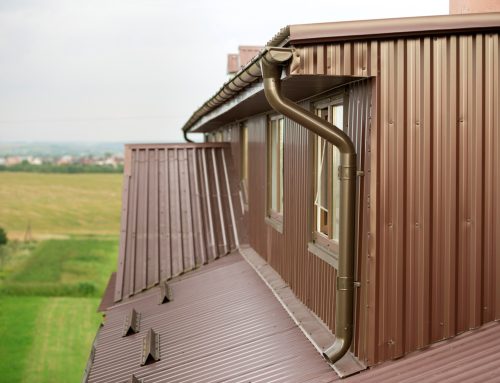Eavestroughs, soffits, and fascia are all components of a building’s roofing system. Together, they maintain the integrity and longevity of your home’s structure as well as ensure the comfort and safety of its inhabitants. Each serving different purposes, the eavestrough, soffits, and fascia are responsible for water management, moisture control, and roof protection.
Eavestrough
An eavestrough, also known as gutter, is a type of trough that is installed along the edge of the roof to catch rainwater as it flows off the roof’s surface during precipitation events. Once collected, eavestroughs channel the rainwater along their length, directing the water towards downspouts or drain pipes. Attached to the eavestroughs, downspouts or drain pipes carry the rainwater down to the ground level, where it is then safely directed away from the foundation of the building.
By effectively managing rainwater runoff, eavestroughs help prevent water from pooling on the roof, overflowing onto exterior surfaces, or collecting near the foundation. This helps protect the roof, walls, windows, doors, landscaping, and foundation from water damage and deterioration. Properly functioning eavestroughs help preserve the structural integrity of the building by preventing water infiltration into the roof, walls, and foundation. This reduces the risk of structural damage, mold growth, and other moisture-related issues that can compromise the stability and longevity of the structure.
Eavestroughs play a critical role in managing rainwater runoff from the roof, protecting the building from water damage and preserving its structural integrity. Regular maintenance and cleaning of eavestroughs or gutters are essential to ensure they remain free of debris and clogs, allowing them to function effectively and efficiently.
Soffits
Soffits are the underside of the roof overhang, extending from the exterior wall to the edge of the eaves. One of the primary functions of soffits is to provide ventilation to the attic space. Soffit vents allow fresh air to enter the attic while allowing hot, moist air to escape. Proper ventilation provided by soffits helps prevent moisture buildup in the attic, which can lead to mold growth, wood rot, and deterioration of roofing materials. By promoting airflow, soffits contribute to maintaining a dry and healthy attic environment, reducing the risk of moisture-related issues. Adequate attic ventilation provided by soffits helps improve energy efficiency by reducing the need for mechanical cooling in the summer and preventing ice dams in the winter. Proper ventilation helps regulate indoor temperatures, reducing energy consumption and utility costs.
Soffits also contribute to the aesthetic appearance of your home’s exterior. They cover the underside of the roof overhang, providing a finished and cohesive look to the eaves. Soffits come in a variety of materials, styles, and colors, allowing you to customize the appearance of your home’s exterior and enhance its curb appeal.
Soffits play a critical role in promoting attic ventilation, preventing moisture damage, enhancing energy efficiency, and improving the aesthetic appearance of the building exterior. Proper installation and maintenance of soffits are essential for ensuring their optimal performance.
Fascia
The fascia are the vertical board or panels that cover the ends of the roof rafters or trusses along the eaves. One of its primary functions is to provide a stable mountain surface for eavestroughs or gutters. Typically installed along the lower edge of the roofline, fascia boards support the weight of the guttering system. This ensures that the eavestroughs or gutters are securely attached and properly aligned for effective water management. Fascia boards cover the ends of the roof rafters or trusses, protecting the edges of the roof from weather damage, such as water infiltration, wind uplift, and UV exposure. By providing a protective barrier, fascia helps prevent the deterioration of roofing materials and extends the lifespan of the roof.
Fascia also helps secure soffits, which are installed beneath the eaves of the roof. Together, the soffit and fascia provide ventilation to the attic space. Covering the exposed edges of the soffits, fascia boards provide support and protection while enhancing the overall appearance of the roofline. Like soffits, fascia boards come in a variety of materials, styles, and colors.
Fascia plays a critical role in supporting guttering, protecting roof edges, securing soffits, and enhancing your home’s aesthetic appearance. As with soffits, proper installation and maintenance of fascia are essential for ensuring its structural integrity.
Together, eavestroughs, soffits, and fascia form a comprehensive system that effectively manages rainwater runoff, promotes ventilation, and protects the roof and foundation of the house from moisture-related issues, keeping your home dry and structurally sound. Proper installation, maintenance, and repair of these components are essential for ensuring their optimal performance and prolonging the lifespan of your roof. If you have a home improvement project that involves repairing or installing eavestroughs or soffits and fascia, working with a professional can ensure an expert assessment of your roofing system and proper repair of installation of these components.






